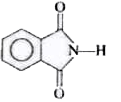On strongly heating, a blue salt leaves a black residue. Which of the following cations can be present in the salt?
Fe2+
Fe3+
Cu2+
Zn2+
The correct Answer is:C
To solve the question regarding which cation can be present in a blue salt that leaves a black residue upon strong heating, we can follow these steps:
1. Identify the Color of the Salt:
- The problem states that the salt is blue. We need to identify which cations typically form blue salts.
2. Analyze the Given Cations:
- The cations provided are:
- Fe²⁺ (ferrous)
- Fe³⁺ (ferric)
- Cu²⁺ (cupric)
- Zn²⁺ (zinc)
- We know that:
- Fe²⁺ salts are usually green.
- Fe³⁺ salts are typically yellow or brown.
- Cu²⁺ salts are blue (e.g., copper(II) sulfate).
- Zn²⁺ salts are white (e.g., zinc sulfide).
3. Determine the Likely Cation:
- From the analysis, only Cu²⁺ (cupric) forms blue salts, such as copper(II) sulfate (CuSO₄·5H₂O).
4. Heating the Blue Salt:
- When copper(II) sulfate is strongly heated, it undergoes decomposition:
- The hydrated form (blue) loses water and becomes anhydrous (white).
- Further heating leads to the formation of copper(II) oxide (CuO), which is black, and sulfur trioxide (SO₃) gas is released.
5. Identify the Black Residue:
- The black residue formed after heating is copper(II) oxide (CuO), confirming that the cation present in the original blue salt is Cu²⁺.
6. Conclusion:
- Therefore, the cation that can be present in the blue salt is Cu²⁺.
Final Answer:
The cation that can be present in the blue salt is Cu²⁺ (cupric cation).
---
- The problem states that the salt is blue. We need to identify which cations typically form blue salts.
- The cations provided are:
- Fe²⁺ (ferrous)
- Fe³⁺ (ferric)
- Cu²⁺ (cupric)
- Zn²⁺ (zinc)
- We know that:
- Fe²⁺ salts are usually green.
- Fe³⁺ salts are typically yellow or brown.
- Cu²⁺ salts are blue (e.g., copper(II) sulfate).
- Zn²⁺ salts are white (e.g., zinc sulfide).
- From the analysis, only Cu²⁺ (cupric) forms blue salts, such as copper(II) sulfate (CuSO₄·5H₂O).
- When copper(II) sulfate is strongly heated, it undergoes decomposition:
- The hydrated form (blue) loses water and becomes anhydrous (white).
- Further heating leads to the formation of copper(II) oxide (CuO), which is black, and sulfur trioxide (SO₃) gas is released.
- The black residue formed after heating is copper(II) oxide (CuO), confirming that the cation present in the original blue salt is Cu²⁺.
- Therefore, the cation that can be present in the blue salt is Cu²⁺.
The cation that can be present in the blue salt is Cu²⁺ (cupric cation).
Topper's Solved these Questions
- QUALITATIVE INORGANIC ANALYSISBOOK - VK JAISWAL ENGLISHCHAPTER - QUALITATIVE INORGANIC ANALYSISEXERCISE - LEVEL 3
62 Videos
- QUALITATIVE INORGANIC ANALYSISBOOK - VK JAISWAL ENGLISHCHAPTER - QUALITATIVE INORGANIC ANALYSISEXERCISE - ONE OR MORE ANSWER IS/ARE CORRECT
43 Videos
- QUALITATIVE INORGANIC ANALYSISBOOK - VK JAISWAL ENGLISHCHAPTER - QUALITATIVE INORGANIC ANALYSISEXERCISE - SUBJECTIVE PROBLEMS
4 Videos
- PERIODIC PROPERTIESBOOK - VK JAISWAL ENGLISHCHAPTER - PERIODIC PROPERTIESEXERCISE - MATCH THE COLUMN
11 Videos
- s-BLOCK ELEMENTSBOOK - VK JAISWAL ENGLISHCHAPTER - s-BLOCK ELEMENTSEXERCISE - SUBJECTIVE PROBLEMS
2 Videos
Similar Questions
Knowledge Check
Which of the following compounds can react with base to form salt?
A B
B C
C D
D
Which of the following is epsom salt ?
View SolutionWhich of the following is an acidic salt/
View SolutionWhich of the following is an acidic salt?
View SolutionWhich of the following is an acidic salt?
View SolutionWhich of the following is not an acidic salt ?
View SolutionWhich of the following salts is not hydrolyse?
View SolutionWhich of the following is not a property of diazonium salts?
View Solution
